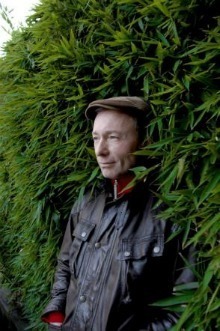Matt Rees's Blog - Posts Tagged "tony-parsons"
The Heart to the Rest of the World: the Writing Life with Tony Parsons
 When you ask writers what underpins the greatest books, they may talk about structure, style, character-building. The best of them identify the novelist’s emotional understanding of himself and his ability to translate it to the page. That’s what strikes readers – perhaps without their even knowing it – and gives them an immediate connection to the work. At this, Tony Parsons is the master. An enfant terrible of rock journalism who’s still a high-profile columnist in British magazines and newspapers, his first big success was the wonderful MAN AND BOY, which was a big word-of-mouth hit around the turn of the millennium. Since then, he has written a series of other books, mostly focusing on the tribulations of relationships. What it takes to maintain a relationship or the love born by bringing a child into the world, for example. He’s done all this with a broad appeal, a lack of pretention, and an understanding of the craft of writing that makes him unique in the London literary world. Here he talks about how he lives his Writing Life:
When you ask writers what underpins the greatest books, they may talk about structure, style, character-building. The best of them identify the novelist’s emotional understanding of himself and his ability to translate it to the page. That’s what strikes readers – perhaps without their even knowing it – and gives them an immediate connection to the work. At this, Tony Parsons is the master. An enfant terrible of rock journalism who’s still a high-profile columnist in British magazines and newspapers, his first big success was the wonderful MAN AND BOY, which was a big word-of-mouth hit around the turn of the millennium. Since then, he has written a series of other books, mostly focusing on the tribulations of relationships. What it takes to maintain a relationship or the love born by bringing a child into the world, for example. He’s done all this with a broad appeal, a lack of pretention, and an understanding of the craft of writing that makes him unique in the London literary world. Here he talks about how he lives his Writing Life:You were a music writer who mixed with the great British punk bands, before you wrote novels. How did the transition to novels change your writing and the way you think about writing?
The transition between journalism and novels is always the same – it is the difference between running 100 metres and running the marathon. If I wrote a review of the Clash or the Sex Pistols, or if I write a column for GQ or a newspaper today, then I can do it in a few hours. With a novel, you live with it for a year or more – you have doubts, you take wrong turnings, you plough on. It is just much more of a slog. And you have to dig deeper – to keep that big picture in your head, to get the book in your brain down on 400 sheets of paper – writing a novel is much more of an act of will. You keep going, even when you lose heart. If you are writing a column – my columns are 2000 words for GQ, and 1229 for the Daily Mirror – you don’t really have the time to get tired, or to let self-doubt creep in.
Would you recommend any books on writing?
There are many great books about writing – I would recommend you read all of them. “Story” by Robert McKee is aimed at screenplay writers, and filmmakers, but the lessons about story structure are just as applicable to novelists. One of my favourite books on writing is Ernest Hemingway on Writing – it is an anthology of thoughts by Hemingway on his craft, rather than a book that he wrote about writing, but it contains some of my favourite advice. For example, Hemingway suggests that if you get stuck then you should write, “One true line.” I have always loved that. Elmore Leonard’s “10 Rules of Writing” is very good, and will take you about 15 minutes to read. I have just discovered “Becoming A Writer” by Dorothea Brande, which came out 80 years ago and has just been discovered – you never stop learning your craft, and so any writer should devour all the good advice he or she can find.
What’s a typical writing day?
A typical day is that I walk my 8-year-old daughter to school, come home and start. I work non-stop until lunch – aim for 1,000 words but keep going if it is going well. Knock off for lunch and do anything and everything else in the afternoon, including thinking about tomorrow’s work. It is always good to have some idea of where you are starting the next day. Hemingway said you should always, “Leave some water in the well.” So – 1000 words a day, before lunch. But there will be weeks when I am editing a book, and then you move at a different pace. Or obviously you don’t start off with 1000 words – the brooding period, when you are trying to see the book in your head. But when the ocean liner is out at sea, I will try to hit that 1000 word mark day after day.
Novels need perhaps to make a greater emotional connection with a reader than journalism. Before I was two paragraphs into “Man and Boy,” I was in tears, though you hadn’t written anything overtly tear-jerking. The same was true when I heard you speaking to an audience about your father—you were very measured and matter-of-fact, yet it was somehow deeply touching. How do you do it?
I think you just have to be emotionally honest – with yourself and everyone else. If you are writing or talking. Just try to say what is in your head and your heart without worrying too much about how it makes you look. So I just try to be straight with the world and myself, and I find that you can’t go far wrong. I think we spend a lot of our lives trying to look more cool or clever or uncaring than we really are – I think a writer has to get over that, and find the connection from his heart to the rest of the world.
What’s your favorite sentence in all literature, and why?
“It was now too late and too far to go back, and I went on, and the mists had all solemnly risen now, and the world lay spread before me.” From Great Expectations, Charles Dickens. I don’t think Dickens gets the credit he deserves for being a beautiful writer. We revere him for his characters and his stories of course, but there is a beautiful evocative simplicity about his prose. He really was just such an incredible all-round writer – that passage haunts me. An editor would tell you that you shouldn’t use “now” twice in the same sentence, and I wonder if it was deliberate or not. I think it was – because it is just such a perfect and incredible sentence.
What’s the best descriptive image in all literature?
I am rereading My Family and Other Animals by Gerald Durrell, about an upper class English family running off to Corfu in the 1930s, and I love the way Durrell writes – this is one of my favourite parts, where he compares the new day to a child’s transfer. “Gradually the magic of the island settled over us as gently and clingingly as pollen. Every day had a tranquillity, a timelessness about it, so that you wished it would never end. But then the dark skin of night would peel off and there would be a fresh day waiting for us, glossy and colourful as a child’s transfer and with the same tinge of unreality.”
Read the rest of this post on my blog The Man of Twists and Turns,/a>
Published on April 05, 2011 00:00
•
Tags:
dorothea-brande, elmore-leonard, ernest-hemingway, gq, man-and-boy, the-clash, the-daily-mirror, the-sex-pistols, the-writing-life, tony-parsons, writers, writing
Lazy Writers and Productive Creatives
 There are lazy writers, writers who can’t say no, and then there are creative people who are able to combine their muse with their media.
There are lazy writers, writers who can’t say no, and then there are creative people who are able to combine their muse with their media.I’ve discovered this in recent months a couple of different ways. First, on a recent book tour, I spent a week at a book festival where I was together with the same bunch of authors all week. I asked many of them if they’d agree to be interviewed over email for my blog. All said yes. Some very significant writers, including UK bestseller Tony Parsons, wrote swift responses to my questions, and you can read them here on my blog.
Others agreed to do the interview only to prevaricate when I sent the questions. They suggested that they’d be able to get to the interview once they’d finished a current freelance project or completed a three month writing fellowship. Now, I don’t believe it takes long to write the answers to my questions, so either they were blowing me off or they harbored deep reservations against….work – or they think a blog interview is a more serious thing than I do…. Several others gave me email addresses which turned out not to exist, but they were all somewhat elderly ladies, so I’m prepared to ascribe that to forgetfulness and lack of internet savvy rather than a desire to throw me off the scent.
More recently, I asked Tess Gerritsen, the best-selling US thriller writer
whom I also met at a book fair, if she’d read my (forthcoming in the US,
currently available in the UK) historical mystery MOZART’S LAST ARIA and
perhaps supply a comment on the book – favorable of course – for my
publishers to post on the cover. In the business, it’s called a “blurb.”
Even though she embarked last month on three months of daily readings to
promote her excellent new novel THE SILENT GIRL – a strenuous schedule that includes no fewer than two book readings a day in its UK stretch – Tess
zipped back her blurb double-quick. “Mozart, music, and murder seamlessly
blend together in this fascinating historical mystery. A perfect read to go
with a crackling fire and a pot of hot chocolate,” Tess wrote.
Read the rest of this post on my blog.
Published on August 18, 2011 05:48
•
Tags:
blurbs, crime-fiction, historical-fiction, mozart-s-last-aria, nannerl-mozart, tess-gerritsen, tony-parsons, wolfgang-mozart, writers



